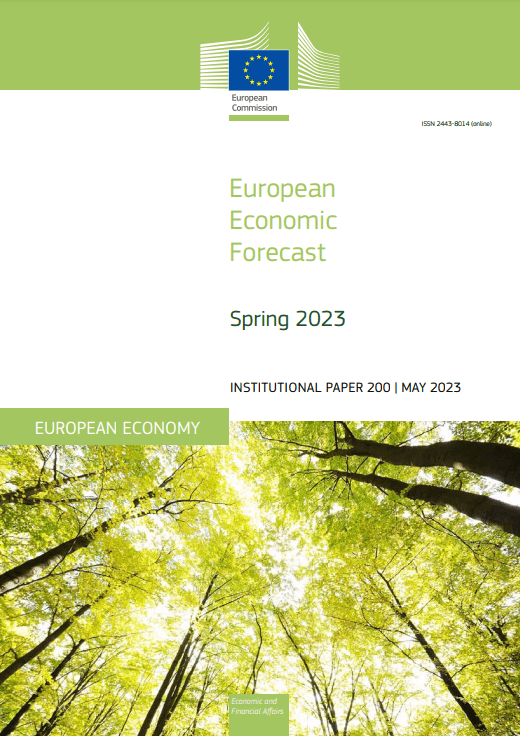Following strong expansion in 2022, economic activity is expected to slow down in 2023. Labour market resilience and the implementation of the Recovery and Resilience Plan (RRP) are set to sustain growth, which is forecast to accelerate further in 2024.
Headline inflation is projected to moderate on the back of to lower energy prices. The still high general government deficit is set to keep decreasing but more gradually than in the past two years due to slower revenue growth.
| Indicators | 2022 | 2023 | 2024 |
|---|---|---|---|
| GDP growth (%, yoy) | 5,5 | 1,9 | 2,0 |
| Inflation (%, yoy) | 8,3 | 4,0 | 2,7 |
| Unemployment (%) | 12,9 | 12,7 | 12,4 |
| General government balance (% of GDP) | -4,8 | -4,1 | -3,3 |
| Gross public debt (% of GDP) | 113,2 | 110,6 | 109,1 |
| Current account balance (% of GDP) | 0,6 | 1,6 | 1,5 |
Economic activity is expected to gradually pick up
The Spanish economy posted growth of 5.5% in 2022. The strong outturn stemmed from a very positive first half of the year, favoured by revived private consumption and the impulse provided by the rebound of tourism. In the second half of the year, real GDP growth slowed down significantly due to widespread price pressures affecting consumption and investment.
In the first quarter of 2023, real GDP recorded a quarterly growth of 0.5%, largely driven by the contribution from external demand thanks to the solid performance of the tourism sector. Economic activity is forecast to expand by 1.9% this year overall, also benefiting from a stronger carry-over effect from 2022 than previously anticipated. Over the year, consumption is set to recover from the contraction in 2022-Q4 and 2023-Q1, underpinned by the continued resilience of the labour market and real income gains for pensioners and workers on minimum wage. The continuous mobilisation of RRP funds is set to contribute to sustaining investment, notably in non-residential construction, while lower expected import prices and eased supply-chain bottlenecks should favour the pick-up in equipment, following the sharp downturn in the second half of 2022. The full recovery of international tourism to pre-pandemic levels and the positive effect on competitiveness arising from expected lower energy prices are set to further improve the performance of the external sector. The gap with the pre-pandemic output level (2019-Q4), standing at 0.9% in 2022-Q4, is now set to be closed between the second and the third quarter of 2023. Real GDP growth is projected to accelerate in 2024 to 2.0% on the back of invigorated domestic demand, including a stronger contribution of investment.

Spring 2023 Economic Forecast
|
Downside risks to the outlook relate to the adverse impact of the tightening of financial conditions on households’ and firms’ financial position, in view of the elevated level of external, public and private debt. Moreover, for households, while the bulk of new mortgage loans are granted with fixed interest rates, the outstanding stock remains concentrated on variable-rate loans.
Strong labour market amid increasing wage pressures
The labour market performed well in 2022 on the back of sustained job creation and the reduction in the share of temporary employees in the private sector. The unemployment rate reached 12.9% in 2022. It is projected to remain elevated, albeit on a slightly declining trend, down to 12.7% in 2023 and to 12.4% in 2024. Following the significant decline in real terms during 2022, nominal wage growth is expected to accelerate in 2023, although still remaining marginally below the average annual inflation for this year.
Inflation to decelerate on the back of lower energy prices
Headline inflation reached 8.3% on average in 2022 but declined to 5.7% y-o-y in 2022-Q4 and is expected to further decelerate in 2023 mainly due to the moderation of energy prices. Moreover, the extension until end-2023 of most of the government support measures adopted last year and the introduction of additional ones, including the VAT reduction on several food products are also projected to contribute to the progressive decline of headline inflation. Overall, it is forecast to reach 4.0% in 2023 and further decrease to 2.7% in 2024. Nonetheless, the pass-through from energy and food prices to other goods and services, which became increasingly visible from the last quarter of 2022, is set to prompt core inflation to remain elevated over the forecast horizon. Upside risks resulting from a more rapid wage adjustment, stemming also from the extension of inflation clauses and the 8% increase in the minimum wage, could feed into still higher core inflation.
The government deficit is set to continue to reduce although revenue dynamism fades
The public deficit continued to improve in 2022, declining to 4.8% of GDP, essentially driven by strong revenues. Corporate income tax revenue grew by 11.1%, reflecting the recovery of profits after the pandemic, while dynamic job creation supported the solid performance of personal income tax revenues, which grew by 16.2% in 2022. VAT revenue also recorded double-digit growth (13.1%) driven by strong private consumption, the recovery of international tourism, the dynamism of the housing sector and the sharp increase in nominal imports.
The net budgetary cost of the energy support measures is projected in the Commission 2023 spring forecast at 0.6% of GDP in 2023, compared with 1.6% in 2022. The reduction of taxes on electricity and gas and the social voucher have been extended, while the fuel rebate has become more targeted. Available data for the first months of 2023 points to continued dynamism of revenues but with some deceleration, which is expected to continue over the course of the year. On the expenditure side, moderate growth is projected, in line with nominal GDP. Deficit developments in 2023 are also affected by the assumed complete phasing out of COVID-19 emergency temporary measures, which are estimated to have amounted to 0.5% of GDP in 2022. The general government deficit is set to narrow, but more gradually than previously, to 4.1% of GDP in 2023.
The Commission currently assumes a full phasing out of almost all energy support measures in 2024., contributing to the decline of the deficit to 3.4%. The debt-to-GDP ratio declined strongly in 2022, by 5.1pps. to reach 113.2%, driven by high nominal GDP growth. Public debt is projected to keep decreasing, but more gradually, to 111.5% in 2023 and 110.3% in 2024 also due to nominal GDP growth.







Leave a Reply